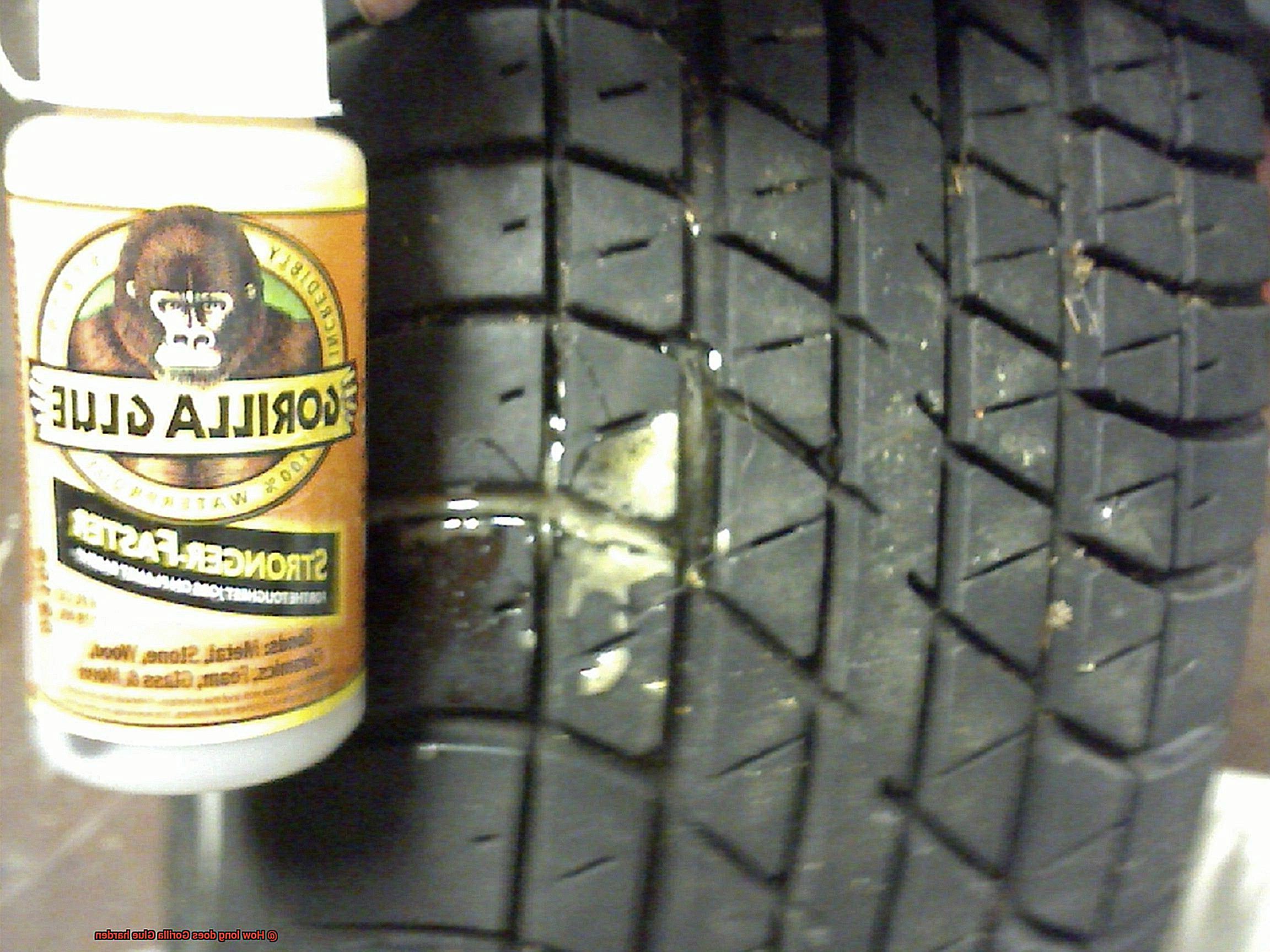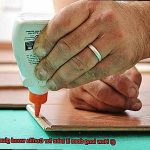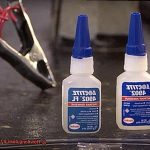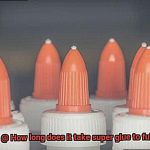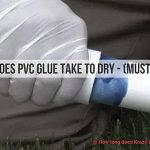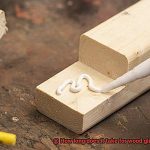Welcome to our blog post all about the incredible world of Gorilla Glue and its hardening time. If you’re a DIY enthusiast or just someone who loves fixing things, chances are you’ve crossed paths with this super adhesive. Whether you’re mending a beloved ceramic vase, joining wood pieces together, or reinforcing your favorite pair of kicks, Gorilla Glue has become the go-to choice for many. But now it’s time to tackle a burning question: How long does Gorilla Glue need to harden?
The hardening process of Gorilla Glue is no ordinary affair. It’s like watching a chemical magic show unfold before your eyes. While other glues rely on solvents evaporating to harden, Gorilla Glue takes a different route. It harnesses the power of moisture for its curing process. When this glue encounters water or any kind of moisture, it expands and foams, creating an insanely strong bond. But here’s the kicker: The time it takes for this magical transformation to happen depends on a few key factors like temperature, humidity levels, and the materials you’re sticking together.
So let’s dive right in and explore the specific hardening times for different types of Gorilla Glue. Armed with this knowledge, you’ll be able to choose the perfect glue and achieve mind-blowing results for your project.
What is Gorilla Glue?
Contents
- 1 What is Gorilla Glue?
- 2 How Does Gorilla Glue Harden?
- 3 Factors Affecting Drying Time of Gorilla Glue
- 4 Ideal Conditions for Hardening of Gorilla Glue
- 5 Tips for Accelerating the Hardening Process
- 6 Benefits of Using Gorilla Glue
- 7 Safety Precautions When Using Gorilla Glue
- 8 Common Mistakes to Avoid When Using Gorilla Glue
- 9 Conclusion
When you find yourself in a sticky situation, desperately needing an adhesive that can bond almost anything, look no further than Gorilla Glue. This go-to adhesive has earned a formidable reputation among professionals and DIY enthusiasts alike. In this article, we will delve into the fascinating world of Gorilla Glue, exploring its exceptional features, versatile application methods, and optimal drying time. So, let’s put on our safety goggles and embark on a journey to uncover the power of Gorilla Glue.
Key Features:
Gorilla Glue is renowned for its exceptional bonding capabilities. Here are some key features that set it apart from the rest:
- Versatility: Like a superhero bringing different surfaces together in perfect harmony, Gorilla Glue has the power to bond wood, metal, ceramic, stone, glass, and even plastic. It is the ultimate adhesive for all your project needs.
- Waterproof: While some adhesives lose their strength when exposed to moisture, Gorilla Glue remains strong and durable. It can withstand both indoor and outdoor projects, from rain-soaked garden decorations to steamy hot showers.
- Expanding Nature: Gorilla Glue’s secret weapon lies in its ability to expand when in contact with moisture. This expansion allows it to fill gaps and cracks, creating an even stronger bond. However, be cautious not to use excessive amounts of glue as it can lead to excessive expansion.
Application Methods:
To cater to your specific needs, Gorilla Glue comes in different forms:
- Liquid Glue: The most common form of Gorilla Glue is perfect for general bonding purposes. Apply it evenly on both surfaces and clamp them together for optimal results.
- Gel Glue: If precision is key or you require vertical applications, gel glue offers more control during application, ensuring a mess-free process.
- Tape: For quick fixes or temporary solutions, Gorilla Glue tape is your best friend. It provides a convenient option for small repairs or holding things together temporarily.
Drying Time:
The burning question on everyone’s mind is: how long does Gorilla Glue take to dry? The drying time can vary depending on factors such as temperature, humidity, and the materials being bonded.
In most cases, Gorilla Glue begins to cure within 1-2 hours. However, for a full cure, it is recommended to wait at least 24 hours. During this period, it is crucial to avoid putting any stress or pressure on the glued area to ensure a strong and durable bond.
If time is of the essence and you need a faster drying time, you can use a hairdryer or apply heat carefully. However, exercise caution as haste can lead to waste, and overheating or damaging the materials should be avoided at all costs.
Gorilla Glue is the ultimate adhesive that offers unparalleled bonding strength and durability. With its ability to join different materials, resistance to water, and expanding nature, it is the go-to choice for various projects. Whether you are crafting, repairing, or creating something entirely new, Gorilla Glue has got your back.
How Does Gorilla Glue Harden?
Prepare to embark on a captivating journey through the enigmatic world of Gorilla Glue’s hardening process. As we explore the extraordinary science behind this adhesive superhero, you’ll witness its remarkable ability to bond almost anything and discover how it metamorphoses from a liquid into an unyielding force. Brace yourself for an adventure like no other as we unravel the secrets of Gorilla Glue’s super hardening powers.
The Polyurethane Base:
At the heart of Gorilla Glue lies its secret weapon: a polyurethane-based formula. This ingenious composition enables the glue to undergo a mesmerizing chemical reaction when it encounters moisture or humidity.
Expanding and Foaming Action:
Prepare to be amazed as Gorilla Glue springs into action upon contact with moisture, embarking on a breathtaking journey of expansion and foaming. This awe-inspiring characteristic ensures not only maximum contact and adhesion between surfaces but also fills every nook and cranny, leaving no gap or void unfilled.
Pressure for Unbreakable Bonds:
But that’s not all – the expanding foam harbors an extraordinary power. It exerts pressure, defying the odds and forging unbreakable bonds between materials. Whether confronted with uneven or irregular surfaces, this added strength guarantees a connection that endures the test of time.
Drying and Hardening:
As the foam completes its dazzling performance, Gorilla Glue gradually transitions into a new phase – drying and hardening. Witness the magic unfold before your eyes as the foam collapses, leaving behind a solidified adhesive that rivals the strength of ancient stones. This hardened bond is more than just resilient; it defies water, temperature fluctuations, and even certain chemicals.
Factors Affecting Curing Time:
Yet, remember that even miracles have their pace. Gorilla Glue typically dries within 1-2 hours, but the full strength development may take up to 24 hours. Temperature and humidity, like fickle companions, influence the curing process. In colder climates or arid environments, patience is a virtue, while warmer temperatures and higher humidity accelerate the transformation.
Factors Affecting Drying Time of Gorilla Glue
The drying time of Gorilla Glue, a popular adhesive, is influenced by a multitude of factors. Join me on this scientific exploration into the world of adhesive drying times as we examine these factors.
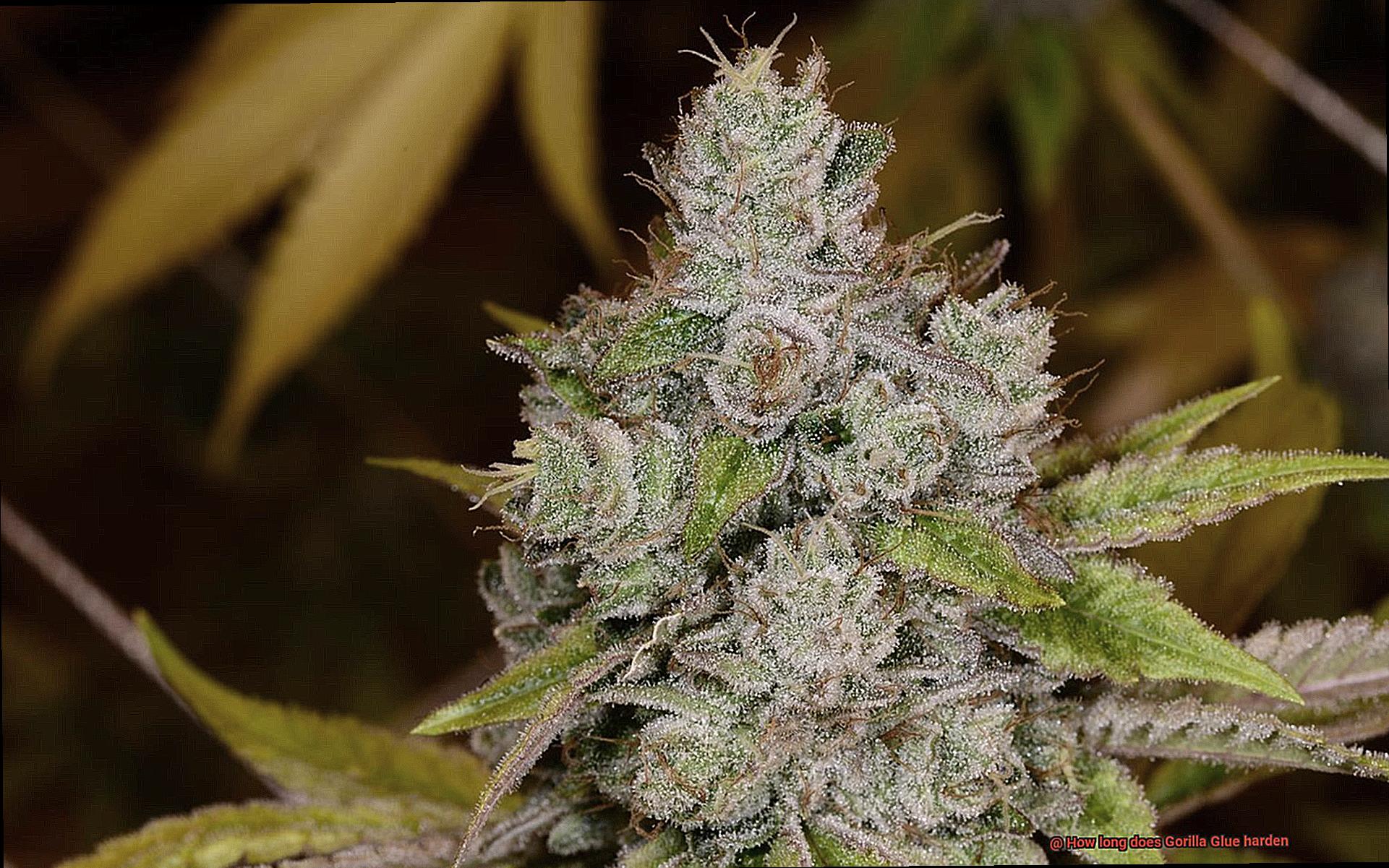
First and foremost, let’s talk temperature. Just like Goldilocks and her porridge, Gorilla Glue prefers its environment not too hot and not too cold. Warmer temperatures accelerate the drying process, while chilly temperatures can slow it down. However, extreme temperatures can compromise the quality of the glue bond, so finding that sweet spot is crucial.
Now, let’s delve into humidity. Imagine applying Gorilla Glue on a humid summer day, only to find it taking forever to dry. High humidity levels in the air impede water evaporation from the glue, prolonging the drying process. Conversely, low humidity levels facilitate faster drying as there is less moisture to contend with.
Thickness matters too. If you’re applying a thick layer of Gorilla Glue, brace yourself for a longer wait. Thick layers take more time to dry compared to thin ones, so it’s best to apply a thin and even layer for quicker results.
The porosity of the material being glued also comes into play. The more porous the material (like wood or paper), the more moisture it absorbs from the glue, extending the drying time. In contrast, non-porous materials like metal or glass do not absorb moisture, resulting in faster drying.
Applying pressure and using clamps during the drying process can be a game-changer. Not only does it improve bonding strength but it also reduces drying time. The pressure helps squeeze out excess air and ensures maximum contact between the glue and substrate, expediting the curing process.
Moisture content is another factor to consider. Both the adhesive and substrate should be dry before applying Gorilla Glue for optimal results. Moisture on either surface can interfere with curing and prolong drying time.
Last but not least, not all Gorilla Glue products are created equal. The specific type being used can affect the drying time. Therefore, it’s essential to refer to the manufacturer’s instructions for accurate drying time information.
Ideal Conditions for Hardening of Gorilla Glue
Prepare to embark on a magnificent journey into the enchanting realm of Gorilla Glue. Whether you’re a seasoned DIY aficionado or an inquisitive glue enthusiast, this guide will unveil the secrets behind achieving flawless hardening conditions for this extraordinary adhesive. Get ready to dive into the world of stickiness and discover how to forge bonds that are unbreakable and resilient. Let’s explore the optimal conditions for Gorilla Glue hardening together.
Temperature – The Goldilocks Zone:
Much like Goldilocks and her quest for porridge perfection, Gorilla Glue has its own temperature preferences. To achieve impeccable hardening, apply Gorilla Glue within the temperature range of 50°F to 90°F (10°C to 32°C). If it’s too cold, the glue will be sluggish in drying; if it’s too hot, the bond’s strength could be compromised. It’s all about finding that “just right” temperature for the perfect union.
Humidity – A Delicate Dance with Moisture:
Humidity levels can make or break your glue game. Aim for a relative humidity between 40% and 60% during the curing process. High humidity can slow down drying time, while low humidity might result in feeble bonds. Remember, different Gorilla Glue products have varying tolerance levels to humidity, so be sure to consult those sacred instructions.
Pressure – The Game-Changer:
When it comes to bonding, applying pressure is like adding an extra dose of power. Squeeze those surfaces together tightly to maximize contact between the adhesive and materials. Clamps or weights can become your trusty sidekicks here. Just make sure you follow Gorilla Glue’s recommendations for each specific project and material, allowing that bond to flourish.
Drying Time – Patience is a Virtue:
Ah, drying time – the ultimate test of patience. While Gorilla Glue may appear dry on the surface after a few hours, don’t be fooled. Grant it at least 24 hours, or even longer if you dare, to fully cure. Trust us, the wait is worth it. During this period, avoid any movements or disturbances so that your bond emerges as an invincible force against whatever life throws its way.
Temperature:
- The temperature at which Gorilla Glue is applied and allowed to cure significantly affects its hardening process.
- For optimal results, it is recommended to apply Gorilla Glue within a temperature range of 50°F to 90°F (10°C to 32°C).
- Extremely low temperatures can considerably slow down the curing process, while excessively high temperatures may compromise the bond’s strength.
- Avoiding drastic temperature fluctuations is crucial since they can impact the performance and drying time of Gorilla Glue.
Tips for Accelerating the Hardening Process
We’ve got you covered. In this article, we’ll share some fantastic tips and techniques to help you speed up the hardening process of Gorilla Glue. Whether you’re working on a craft project or tackling a home repair, these tips will have your glue drying in no time.

Apply Heat:
To accelerate the hardening process, apply heat to the glued area. Gently warm it with a heat gun or hairdryer on a low heat setting. Be cautious not to overheat the glue, as it can weaken the bond. Heat activates the curing agents in Gorilla Glue, helping it dry faster and form a strong bond between materials.
Add Moisture:
Gorilla Glue requires moisture to cure properly. If you’re working with dry materials or in a dry environment, add a small amount of water to the glue. This added moisture will help accelerate the hardening process. Just remember not to add too much water, as it can dilute the glue and weaken the bond.
Apply Pressure:
Applying pressure is crucial for Gorilla Glue to cure effectively. Use clamps or any other suitable method to hold the materials tightly together until the glue hardens. The pressure helps squeeze out excess air and enhances the strength of the bond. Make sure to adjust the pressure according to the specific application and materials involved.
Proper Surface Preparation:
Before applying Gorilla Glue, clean and dry the surfaces thoroughly. Dust, dirt, or grease can interfere with the bonding process and slow down curing time. Use mild soap and water with a clean cloth or sponge to clean the surfaces before applying the glue. Ensure they are completely dry to optimize adhesion and expedite the hardening process.
Choose the Right Variant:
Gorilla Glue offers different variants designed for specific applications and materials. Take some time to understand the characteristics and recommended uses of each variant. Choosing the right type of Gorilla Glue for your project can help optimize the hardening process and ensure maximum strength. Refer to the product instructions or seek professional advice if needed.
Benefits of Using Gorilla Glue
Look no further. Gorilla Glue is here to save the day. This exceptional adhesive has gained a reputation for its extraordinary strength, versatility, and durability, making it the go-to choice for DIY enthusiasts, craftsmen, and professionals alike. In this article, we will delve into the world of Gorilla Glue and explore its numerous benefits that set it apart from other glues on the market.
Unmatched Bonding Strength:
Gorilla Glue’s most outstanding advantage is its unparalleled bonding strength. It forms an incredibly robust bond on a wide range of surfaces, including wood, stone, metal, ceramic, and more. Say goodbye to wobbly furniture and hello to secure repairs and intricate crafts that stay firmly in place.
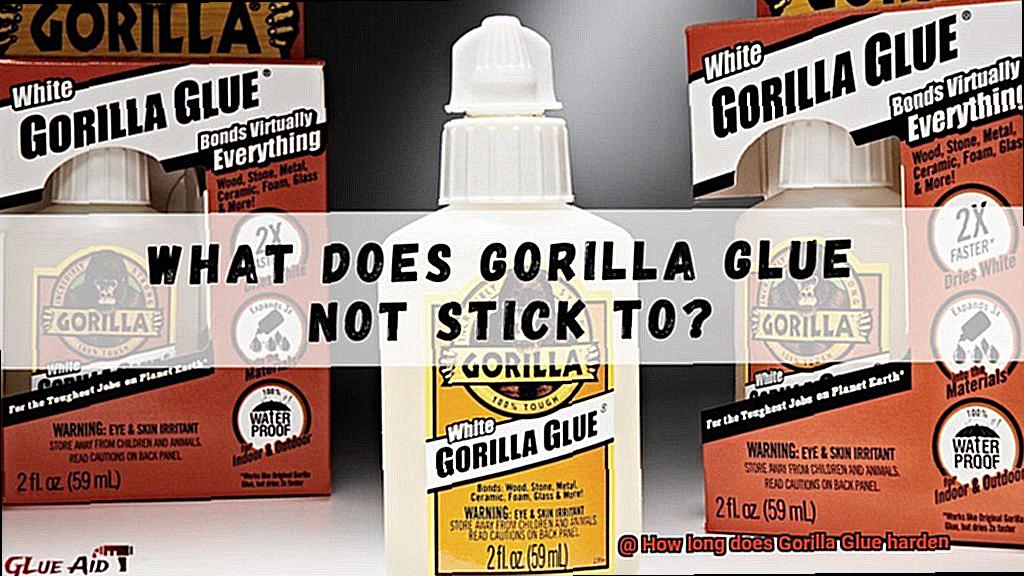
Resistance to Moisture:
No more worries about water weakening your glued items. Gorilla Glue maintains its strength and bonding properties even in wet conditions. Whether you’re working on a bathroom renovation or an outdoor project, Gorilla Glue will withstand the test of time and keep everything securely bonded.
Versatility at Its Best:
Gorilla Glue’s versatility is truly impressive. It can be used on a variety of materials, such as wood, metal, glass, fabric, ceramics, and plastics. From simple household repairs to complex professional projects, Gorilla Glue has got you covered for all your DIY needs.
Unrivaled Durability:
Once cured, Gorilla Glue creates a bond that can withstand heavy loads and resist impacts. No need to worry about your glued items falling apart under stress; Gorilla Glue ensures that everything stays securely joined. This exceptional durability makes it the adhesive of choice for demanding projects that require long-lasting strength.
Gap-Filling Properties:
Working with irregular or uneven surfaces? No problem. Gorilla Glue expands as it cures, allowing it to fill in gaps and provide a seamless bond. This feature is a game-changer when dealing with tricky surfaces, ensuring a strong and flawless result every time.
Easy to Use:
Unlike some adhesives that require constant pressure or clamping during the curing process, Gorilla Glue only needs a small amount of pressure to create a strong bond. This makes it incredibly convenient and easy to use for a variety of applications. No more complicated techniques, just hassle-free gluing.
Paintable and Stainable:
Want your glued items to seamlessly blend into your desired aesthetic or finish? Gorilla Glue has got you covered. Once cured, it is paintable and stainable, allowing you to integrate the glued items into your project’s final look effortlessly.
Resistant to Extreme Temperatures:
Gorilla Glue can handle both hot and cold environments like a champ. It can withstand temperatures ranging from -40°F to 200°F (-40°C to 93°C). So whether you’re working on a project in scorching heat or freezing cold, Gorilla Glue will maintain its strength and integrity.
Choose Your Formula:
Gorilla Glue is available in various forms, including the original polyurethane formula, clear formula, and gel formula. This allows you to select the perfect type of Gorilla Glue based on your specific needs and preferences. No matter what kind of project you’re tackling, there’s a Gorilla Glue formula just for you.
Safety Precautions When Using Gorilla Glue
Gorilla Glue is a remarkable adhesive that can bond almost any material, but its strength requires careful handling. In this comprehensive guide, we will delve into the essential safety precautions necessary when using Gorilla Glue. By following these measures, you can ensure not only your own safety but also the success of your project.
Read and Understand the Safety Instructions:
Before even opening that bottle of Gorilla Glue, take the time to carefully read and understand the safety instructions provided on the packaging. These instructions contain vital information about potential hazards and how to handle the glue safely. Ignoring or disregarding these instructions can lead to accidents or improper usage.
Wear Protective Gloves:
Protective gloves are an absolute must when working with Gorilla Glue. They serve two crucial purposes: shielding your hands from direct contact with the glue and preventing any potential skin irritation. Opt for nitrile or latex gloves for optimal protection, ensuring a barrier between your skin and the powerful adhesive.
Work in a Well-Ventilated Area:
Ventilation is key when using Gorilla Glue due to the fumes it may release during the curing process. These fumes can be harmful if inhaled in high concentrations. To minimize exposure, work in a well-ventilated area by opening windows or using a fan. This will help dissipate any fumes and ensure better air circulation, safeguarding your respiratory system.
Use Eye Protection:
Your eyes are incredibly sensitive and vulnerable to accidental splashes or drips of Gorilla Glue. Even a small amount can cause eye irritation or more severe damage. Protect your vision by wearing safety goggles or glasses as a simple yet effective precautionary measure. Shielding your eyes will prevent potential injuries and ensure your long-term visual health.
Wash Skin Immediately:
In the event of accidental skin contact with Gorilla Glue, immediate action is crucial. Wash the affected area immediately with soap and water to remove any adhesive residue. If any irritation persists, seek medical attention promptly. Remember, it’s always better to be safe than sorry when it comes to your skin’s well-being.
Avoid Excessive Application:
Gorilla Glue expands as it cures, which means excess glue can cause damage or interfere with the functionality of your project. Apply just the right amount—remember, a little goes a long way with this powerful adhesive. By exercising control during application, you will achieve optimal results without compromising your project’s integrity.
Proper Storage and Disposal:
To preserve the quality and extend the shelf life of Gorilla Glue, store it in a cool, dry place away from the reach of children and pets. Ensure that the container is tightly sealed to prevent moisture from entering and causing premature curing. Additionally, when disposing of unused or expired Gorilla Glue, adhere to local regulations for proper disposal methods. Never pour it down the drain or dispose of it in regular household waste.
Follow Recommended Curing Time:
For a strong and durable bond, strictly adhere to the recommended curing time provided by Gorilla Glue. Rushing the drying process can weaken the bond and compromise your project’s longevity. Exercise patience and allow sufficient time for the glue to cure fully before subjecting it to stress or strain.
Common Mistakes to Avoid When Using Gorilla Glue
When it comes to using Gorilla Glue, there are several common mistakes that you’ll want to avoid in order to ensure the best results for your projects. Here’s a comprehensive list of points to keep in mind:
- Prepare the surface: Before applying Gorilla Glue, make sure to clean the surface thoroughly. Remove any dirt, grease, or old adhesive residue. This will help the glue bond properly and prevent weak or failed bonds.
- Apply the right amount: Using too much glue is a common mistake. Gorilla Glue expands as it cures, so applying an excessive amount can lead to messy and uneven results. Instead, apply a thin layer of glue and spread it evenly over the surface for a strong bond without excessive foaming.
- Dampen porous materials: If you’re working with porous materials like wood or fabric, dampen them with a little water before applying the glue. This helps activate the curing process and promotes stronger bonds.
- Use proper clamping: Gorilla Glue requires pressure for optimal bonding. Make sure to clamp the glued parts together firmly or use weights to keep them in place while the glue cures. This will create a tight and durable bond.
- Remove excess glue in time: Gorilla Glue sets within 1-2 hours, so it’s important to remove any excess before it fully hardens. Once it hardens, removing it becomes more challenging and may damage the surface.
- Store properly: After each use, tightly seal the bottle of Gorilla Glue and store it in a cool, dry place. Exposure to air and moisture can cause the glue to harden prematurely or lose its adhesive properties.
- Also Read: Is Gorilla Super Glue Waterproof?
Conclusion
The hardening process of Gorilla Glue is a crucial aspect to consider when using this adhesive. So, how long does it take for Gorilla Glue to fully harden? Well, the answer depends on several factors.
Firstly, the type of Gorilla Glue you are using plays a significant role in determining the curing time. There are different variants available, such as Original Gorilla Glue, Super Glue, and Epoxy. Each variant has its own unique formulation and may require different amounts of time to fully harden.
Additionally, environmental conditions can also impact the curing time. Factors like temperature and humidity can either speed up or slow down the hardening process. Generally, warmer temperatures and lower humidity levels accelerate the curing process, while colder temperatures and higher humidity levels can prolong it.
On average, Gorilla Glue takes about 24 hours to fully cure. However, it’s important to note that this is just an estimate and actual drying times may vary based on the factors mentioned earlier.
To ensure optimal bonding strength, it is recommended to wait at least 24 hours before subjecting the glued surfaces to any stress or load. This allows sufficient time for the adhesive to reach its maximum hardness and durability.
In conclusion, understanding how long Gorilla Glue takes to harden is essential for achieving successful bonding results. By considering the type of glue being used and taking into account environmental factors, you can ensure proper curing and maximize the adhesive’s effectiveness.

